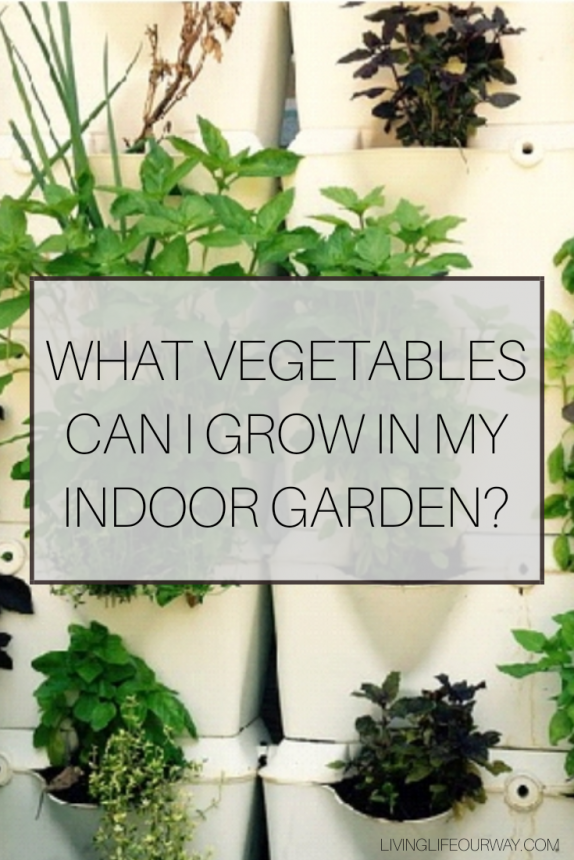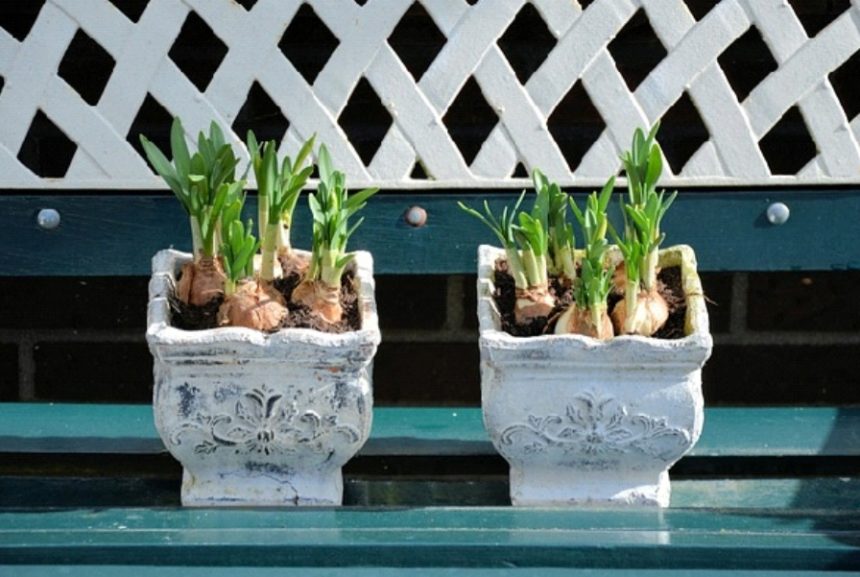If you always admire vegetable gardens as I do, you probably wish you could grow some too. Unfortunately, with the different seasons, the time to grow veggies outdoors is limited. Luckily, you can create a great indoor garden to grow your veggies all year round. Here are a few tips to get you started on your indoor vegetable garden…

Things you need to grow vegetables indoors…
Light and space
If you want to start an indoor garden for vegetables, an ideal place is where you get lots of sunshine. Most veggies require between 6-8 hours of sunlight a day to grow healthy. If your house does not have access to a lot of sunlight, you can use artificial light. An excellent artificial source of light for indoor plants is fluorescent lighting. Fluorescent bulbs are energy and cost efficient and do not put off too much heat.
Containers
You can plant your veggies indoors in pots, window baskets, seedling trays, and hanging arrangements, among other options. Where you plant your vegetables will depend on the space you have. If you are short of space, try creating an indoor vertical garden or a hanging garden with suspended pots.
For vegetable container gardening, pick your pots based on how large the plants are likely to get, so they have space to flourish. For example, scallions can grow in an average size pot of about 4 inches deep, but a tomato plant will need a big container of about 10 to 12 inches deep.
Soil
You need to grow your plants in soil. You can collect soil from any fertile looking area outside. It’s advisable to mix some compost in the soil before planting. Adding compost helps heavy soil have good drainage and improves water retention in porous soil.
To make things simple, you can buy bags of potting mix from your nursery or gardening supplies shop. Potting mix is excellent for growing plants in containers.

Plant nutrition
Your vegetables will also require nutrients to grow in the form of fertilizer. Ask at the nursery which fertilizer is ideal for your vegetables to make the right choice. As your interest grows, you may even be able to make your own compost.
Slow release fertilizer made of fish meal or bone meal is a great pick. Soluble organic fertilizer is another option. You can also make some homemade fertilizer. Fertilizer leaches from the soil as you water, so you need to replenish it every two to three months.
Pests
Growing vegetables indoors will not attract as many pests as in outdoor gardening. You can minimize the likelihood of pests attacking your indoor garden by growing plants from the seed stage.
If, unfortunately, you get a pest infestation, use organic pest solutions, or get an organic pest spray from the gardening supplies store. A quick and effective solution is to call pest solutions services. They will help you to get rid of current pests and give you great ideas on how to prevent future occurrences. If you are across the pond in the USA, a company like Pest Control Experts https://www.pestcontrolexperts.com/exterminator/ will be able to help you with any potential problems you may have with pests in the garden.
These are the basic requirements to grow an indoor vegetable garden. Once you have them, it’s time to pick the veggies you want to plant.

6 Vegetables you can grow indoors all year round…
1. Herbs
I don’t know if you consider herbs vegetables, but many people do. Herbs are easy to grow indoors and always come in handy when you want to make stews or salads.
It’s such a great feeling to cut fresh herbs for your meal as opposed to using wilted ones or dry ones from the grocery store. Some of the herbs that you can try in your indoor vegetable garden are rosemary, cilantro, parsley, basil, chives, and thyme.

2. Microgreens
Microgreens are the tender shoots of veggies that are packed with up to 40 times the nutrients you get from fully grown greens. They are easy to grow and are fantastic in stews, sandwiches, and stir-fries. Some good examples of microgreen you can grow in an indoor garden are arugula, garlic greens, radishes, and baby kale.
Buy microgreen seeds from seed sellers, plant them in seed starting trays and water them with a spray bottle. Place them next to a window with access to sunlight or under some artificial lighting. Within 12 days, your microgreens will be ready for picking.
3. Salad greens
If microgreens are not your cup of tea, try salad greens in your indoor garden. Lettuce is an excellent option as it does not need much to grow. A four-inch deep container is enough to grow lettuce. Keep the soil moist, and the lettuce will sprout in a fortnight.
Growing lettuce is easy because after you pick the leaves, they re-grow. Once you have one or two great lettuce plants, you will have plenty of lettuce for your salad. Try it with romaine lettuce.
4.Tomatoes
Tomatoes are great for an indoor garden because they self pollinate. So you can grow tomatoes indoors all year round using artificial lights. However, many people put their tomato plants outside in summer.
Pick indeterminate tomato varieties as they will keep giving you fruit as opposed to determinate tomato breeds that only fruit for a short time and then stop. Cherry tomatoes are ideal for an indoor garden.

5. Strawberries
If you are looking for a fruit to plant indoors, look no further than strawberries. It’s especially great if your children love strawberries as this is a perfect indoor garden project to do with them.
Strawberries are easy to plant and do not take up a lot of space. You can grow strawberries from a hanging planter next to a window, in a box planter on a window sill, or in a hydroponic setup. Give them fertilizer, light, plus enough water, and you will have juicy strawberries in no time.
6. Scallions
Have you ever set things up ready to cook only to find out you have no onions in your pantry? It happens to the best of us. A great way to solve this problem is to grow scallions in your indoor garden.
Scallions are easy to plant. You can grow them from seeds or leftover bulbs. Just suspend a scallion end over water for a few days, and it will germinate roots. Once you transfer it to the soil, it will grow pretty fast and give you endless scallion shoots for your kitchen needs.

And an extra suggestion…
Mushrooms
Mushrooms are not plants, but they can be part of your indoor garden. Contrary to what many people believe, mushrooms can be easy to grow. They don’t require much light; in fact, they prefer dark or dim places. Mushrooms also grow on substrate, which can be straw, sawdust, coffee grounds, or grains.
For starters, you can use grow-and-spray mushroom kits to get familiar with mushroom cultivation. These kits are easy to set up and maintain. Place the kit in the right environment and follow the instructions on the label. You should have mushrooms growing in two weeks or so. Mushrooms are delicious and highly nutritious, and they grow all year round, so you can harvest your homemade mushrooms no matter the season.
Bonus tip
Do you want to plant different types of veggies in your indoor garden but cannot decide what to pick? Use companion planting. Companion planting is growing vegetables that thrive together. A good example is growing lettuce together with tomatoes, spinach, strawberries, and beets.
It’s easy to have an indoor garden that flourishes all year round. Flowers are great, but when you have something you can eat that helps save you grocery money -that’s smart gardening! The Works also has a good selection of discount gardening, vegan and vegetarian cookbooks too, to help you along the way. Start your indoor garden project today, and see how it goes.
*This is a collaborative post

